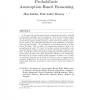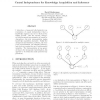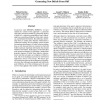UAI
1993
15 years 2 months ago
1993
Based Abstraction and Categorization Eric J. Horvitz∗ and Adrian C. Klein Palo Alto Laboratory Rockwell International Science Center 444 High Street Palo Alto, CA 94301 We take ...
108
Voted
UAI
1993
15 years 2 months ago
1993
In this paper the classical propositional assumption-based model is extended to incorporate probabilities for the assumptions. Then the whole model is placed into the framework of...
103
click to vote
UAI
1993
15 years 2 months ago
1993
We compare the diagnostic accuracy of three diagnostic inference models: the simple Bayes model, the multimembership Bayes model, which is isomorphic to the parallel combination f...
UAI
1994
15 years 2 months ago
1994
We show how to nd a minimum weight loop cutset in a Bayesian network with high probability. Finding such a loop cutset is the rst step in the method of conditioning for inference....
109
click to vote
UAI
1993
15 years 2 months ago
1993
I introduce a temporal belief-network representation of causal independence that a knowledge engineer can use to elicit probabilistic models. Like the current, atemporal belief-ne...
UAI
1993
15 years 2 months ago
1993
We examine two types of similarity networks each based on a distinct notion of relevance. For both types of similarity networks we present an efficient inference algorithm that wo...
UAI
1994
15 years 2 months ago
1994
In previous work [BGHK92, BGHK93], we have studied the random-worlds approach--a particular (and quite powerful) method for generating degrees of belief (i.e., subjective probabil...
UAI
1994
15 years 2 months ago
1994
UAI
1993
15 years 2 months ago
1993
UAI
1993
15 years 2 months ago
1993
: This paper presents and discusses several methods for reasoning from inconsistent knowledge bases. A so-called argumentative-consequence relation, taking into account the existen...



